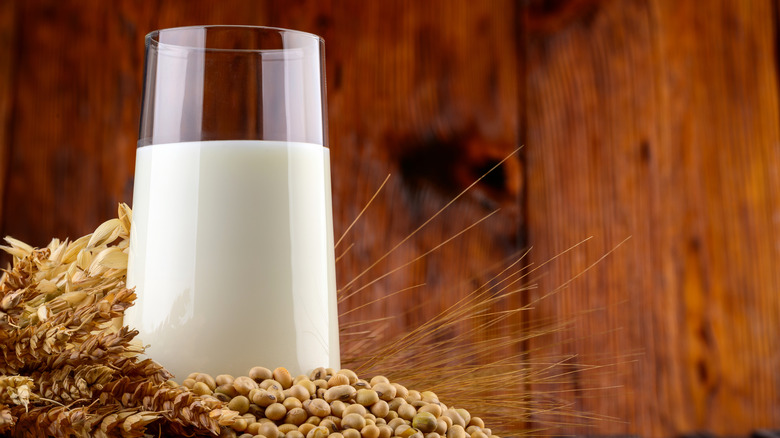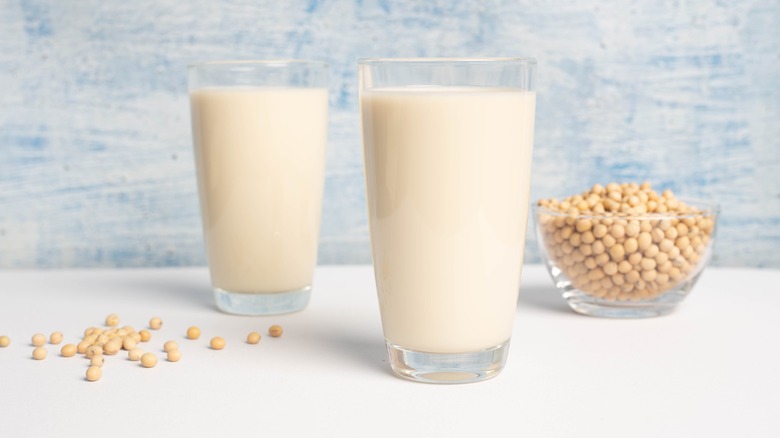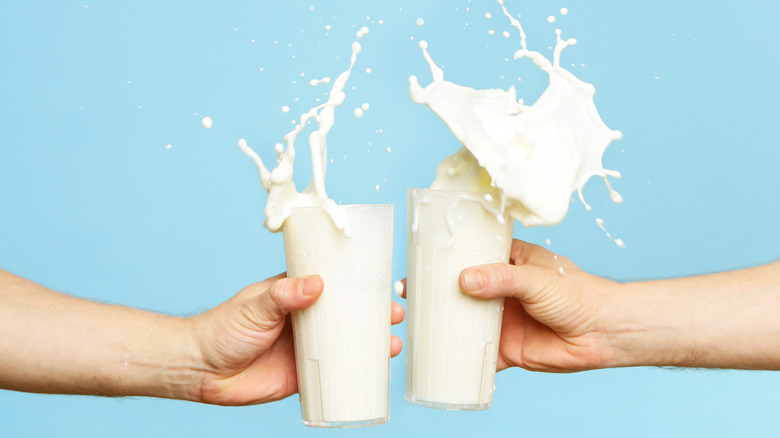Is There A Nutritional Difference Between Soy And Oat Milk?
When looking for plant-based milk, there seem to be millions of opinions as to which one is the best. Some of the decision comes down to personal preference as each kind of milk has its own taste profile. Then there are the nutritional facts about each one that may help shape your decision about which milk is right for you.
Soy milk is the old guard of the plant-based milk world, having been available in stores for years before oat milk became a thing. It's made from soybeans, and it first started being made in China many centuries ago. Oat milk, on the other hand, is the new kid on the block, with only 30 years having passed since its invention in 1994 in Sweden.
Soybeans are legumes that are part of the pea family and they are prized as a good source of vegetable protein. Oats are actually a grain that comes from a family of cereal grasses. Since these two milks have different base ingredients, they definitely have their own distinct nutritional profile.
Nutritional information about soy milk
Americans spent more than $165 million on soy milk in 2022, according to Food Navigator. There are many different types of soy milk -– regular, unsweetened, vanilla, and chocolate. It can also be found in both refrigerated and shelf-stable versions. There's some slight variation between the nutritional data for refrigerated and shelf-stable kinds of soy milk.
A cup of refrigerated unsweetened soy milk has 80 calories, 4.5 grams of fat, 7 grams of protein, and 4 grams of carbohydrates, according to Silk, one of the biggest names in soy milk. The nutritional information for the shelf-stable version is nearly identical except it has an additional gram of protein. Both styles of soy milk have the same significant amount of vitamin D and calcium, which provide 15% and 20% of the daily value needed respectively. They contain a similar amount of iron, vitamin A, and potassium.
The shelf-stable has slightly more vitamin B12 than the refrigerated version, but both offer at least 100% of the recommended daily value. Refrigerated soy milk also offers a few more minerals than the shelf-stable does, including magnesium and folate.
A look at oat milk's nutritional stats
While oat milk is newer to American supermarkets, it has become one of the most popular types of plant-based milk. U.S. shoppers bought more than $527 million in 2022, according to Food Navigator. A cup of Planet Oat unsweetened oat milk has 45 calories, 0.5 grams of fat, 1 gram of protein, and 8 grams of carbohydrates. It contains 20% of the daily recommended amount of vitamin D and 25% of daily amount of calcium.
Oatly, the company that originated oat milk, doesn't sell an unsweetened version of its products. The company explained on its website that it doesn't use any added sugar in its plain oat milk; the sugar in the milk concurs naturally as part of the manufacturing process. Their regular refrigerated oat milk has 120 calories per cup with 5 grams of fat, 3 grams of protein, 7 grams of sugar, and 16 grams of carbohydrates. It has the same amount of vitamin D and calcium as the unsweetened oat milk.
Comparing soy milk and oat milk
It's not a surprise that oat milk and soy milk have similar nutritional stats for calcium and vitamin A as both products have been enriched with nutrients. One striking difference between the two, however, is the amount of vitamin B12. Vitamin B12 is important for heart health and for nerve system support and to prevent anemia. Those who follow a vegan diet may have a hard time getting this vitamin through food sources since it is usually only found in animal products. Soy milk has a substantially larger amount of B12 compared to oat milk, offering 100% to 120% of the daily recommended amount compared to the 10% to 50% found in oat milk.
Another significant nutritional difference between oat milk and soy milk comes into play when looking at the amount of carbohydrates and protein. Soy milk will give you more protein and less carbohydrates than oat milk per cup. This may be more desirable for those watching the carbohydrate intake.



